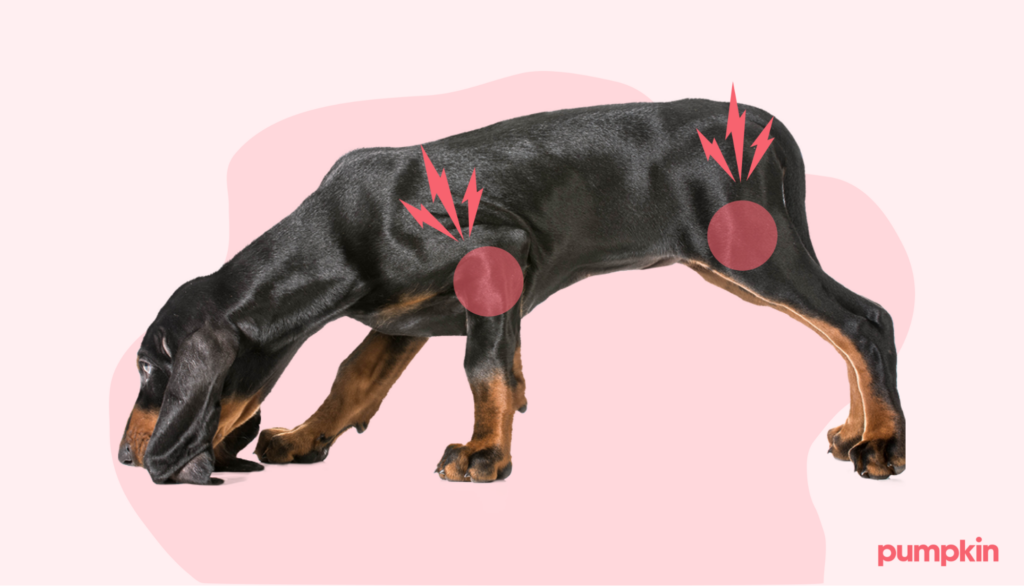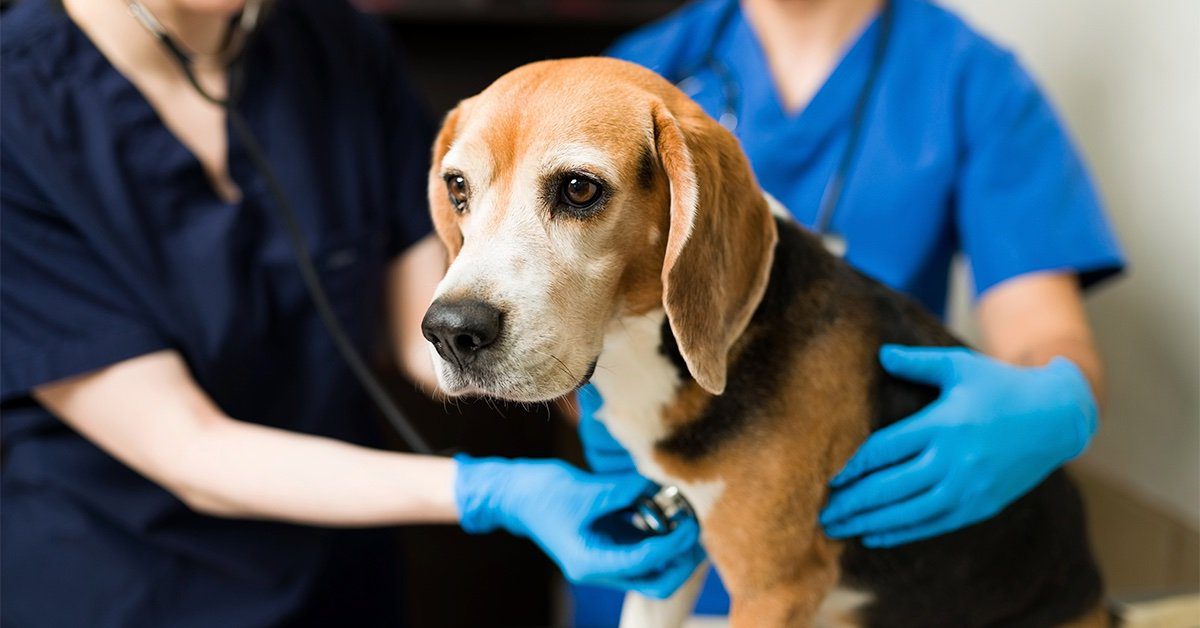Key Points
- While hip dysplasia in dogs is hereditary, it can also result from environmental factors such as obesity, injury, and ligament tears.
- Larger, purebred dogs such as Golden Retrievers, German Shepherds, and Rottweilers are more prone to hip dysplasia than smaller breeds.
- Common hip dysplasia symptoms include decreased activity, lameness in the hind legs, and loss of muscle mass.
Canine hip dysplasia (CHD) occurs when a dog’s hip joint doesn’t develop properly, leading to inflammation, pain, and movement problems in the hind legs.
If you notice that your pup is slowing down or struggling a bit on the stairs, it can be tough to watch — but don’t worry too much yet. While CHD is a genetic condition, you can do plenty to help.
Read on to learn about hip dysplasia in dogs, symptoms to watch out for, and steps you can take to keep your dog comfortable, happy, and wagging their tail.
How do dogs get hip dysplasia?
Knowing a little about a dog’s hip anatomy is helpful in understanding how dogs get hip dysplasia.
The hip is a ball-and-socket joint — think of it as a piece of a puzzle that needs to fit just right. When a puppy grows, the ball and socket must grow simultaneously to ensure they fit smoothly together.
But in some dogs, this growth doesn’t happen as well as it should. This can cause the socket and ball to not align properly or the pelvic muscles to weaken. Ultimately, this then leads to hip dysplasia at a later stage.

When your dog’s femoral head (the tip of their hind legs) and hip socket don’t fit together properly, regular movement can cause pain, cartridge damage, bone spurs, and inflammation.
Although hip dysplasia is inherited, a dog’s environment can also put them at risk for this condition. Besides genetics, some common causes of hip dysplasia include:
- Obesity or overfeeding
- Premature neutering (before full developmental maturity)
- Excessive exercise at a young age
To protect their hip joints, avoid putting your puppy through any surgery or intense exercise until adulthood. Feeding your pup a proper diet is also crucial, especially during their first year of life.
Which breeds are more prone to developing hip dysplasia?
Any dog can develop hip dysplasia. Still, this condition is typically seen in medium to large purebred dogs and giant breeds such as:
- German Shepherds
- Great Danes
- Golden Retrievers
- Newfoundlands
- Rottweilers
- Mastiffs
- Saint Bernards
- Bulldogs
- Old English Sheepdogs
- Pit Bulls
- Chows Chows
Large mixed-breed dogs can also develop hip dysplasia due to their bigger size and genetic background.
Symptoms of hip dysplasia in dogs
Your dog can display hip dysplasia symptoms when they’re just a few months old, but early signs are most common in dogs who are 1 or 2 years old. In other pups, symptoms may not appear until later in life, as the condition can develop alongside other diseases such as osteoarthritis.
Dogs affected by hip dysplasia can exhibit symptoms such as:
- Lameness in the hind legs
- Difficulty or reluctance rising, jumping, running, or climbing stairs
- Wobbly, swaying, or “bunny hop” gait
- Loss of thigh muscle mass
- Stiffness or limping
- Pain
- Grating or looseness in the joint during movement
- Narrow stance
- Stiffness or soreness after rising from rest

These symptoms can vary depending on the advancedness of the condition, the level of inflammation, and the looseness of the joint.
Pet Pro Tip: Illnesses won’t wait to happen. It’s never too early to enroll in pet insurance. From common parasite infections, to costly hereditary illnesses, pet insurance can be worth it and can cover crucial eligible treatment your pet may need for their unexpected accidents and illnesses. Find out how pet insurance works, what pet insurance covers, and choose a plan today.
Because hip dysplasia sometimes develops gradually, it can take years for noticeable signs to appear. That’s why giving your dog the attention and care they need when they’re young is so important. This includes regular vet checkups, a healthy diet, and plenty of playtime.
How is canine hip dysplasia diagnosed?
At a checkup, the veterinarian will gently move your pup’s hind legs to test the hip joint, looking for looseness, reduced range of motion, signs of pain, or grinding sounds.
If your vet suspects hip dysplasia, they may recommend X-rays to get a clearer picture (which may be done under general anesthesia). The vet may also want to do blood work for any signs of inflammation from joint issues.
Tell your vet about any strange behavior or signs you’ve seen in your dog, as well as any new injuries or accidents, even if they seem small.
What’s the treatment for hip dysplasia in dogs?
Dogs with hip dysplasia can receive several types of treatment. Although options will vary depending on the severity of the disease, non-surgical treatments can include:
- Physical therapy
- Joint supplements
- Weight reduction to reduce stress on hips
- Joint fluid modifiers
- Non-steroidal anti-inflammatory drugs (NSAIDs)
- Exercise to stimulate cartilage growth and reduce degeneration
If complications are more severe, non-surgical treatment may not be enough to provide relief. Depending on your dog’s symptoms and age, your vet may recommend these surgical options:

- Femoral head osteotomy (FHO): This procedure can help young and mature dogs manage their pain. Unfortunately, it doesn’t restore normal hip function.
- Double or triple pelvic osteotomy (DPO/TPO): Typically performed in dogs under 10 months old, this procedure reestablishes joint stability and encourages normal joint development.
- Juvenile pubic symphysiodesis (JPS): For very young puppies, this procedure manipulates how the pelvis grows to create a tighter hip, but it doesn’t have very high success rates, making it less common.
- Total hip replacement (THR): In this procedure, the entire joint is replaced with artificial components, giving your dog normal hip function. As one of the most popular hip dysplasia treatments, it has a success rate as high as 90%.
How much does hip dysplasia surgery cost?
Unfortunately, surgical procedures can be very costly. An FHO or DPO procedure can range from $1,500 to $7,000 (not including prescription medications or follow-ups). Your pup typically takes 6-8 weeks to recover from this surgery.
Total hip replacements cost more, ranging from $1,700 to $4,750 and above per hip. Because this is a larger surgery, your pup will take at least 2 months to recover.
Other types of alternative treatments include acupuncture, laser therapy, and stem cell treatments. The prices of these treatments will depend on your dog’s size, age, and severity of condition.
Does pet insurance cover hip dysplasia surgery?
Pumpkin pet insurance plans can help reimburse pet parents for qualifying vet bills, and this includes bills for surgery. However, each case is unique, and your coverage will vary depending on your insurance provider, plan details, and your pet’s medical history. Virtually all pet insurance plans do not cover pre-existing conditions and have some type of waiting period after signup.
If your dog has already been diagnosed with hip dysplasia by the time you sign up for pet insurance, then you won’t be able to get help paying for hip dysplasia treatments. That’s why many pet parents choose to enroll in pet insurance while their dog is still young. Remember: hip dysplasia symptoms can appear when your dog is still a puppy, and it often pays to be proactive with pet insurance coverage.
Additionally, some pet insurance plans specifically exclude hereditary conditions such as hip dysplasia. However, Pumpkin Dog Insurance plans can help cover costs related to hereditary conditions.
In addition to pet insurance, it can help to know if your vet offers or accepts financing options, such as the CareCredit credit card. This is one way to help pay high out-of-pocket costs if your pet needs hip dysplasia surgery or any other accident and illness care. Health and wellness financing options like CareCredit allow you to pay over time for veterinary and pet care costs. A health and wellness credit card and pet insurance can help you be financially prepared to provide your pet with a lifetime of care.*
*Subject to credit approval
Give your dog a normal life
If you’re like most pet parents, finding out your dog has hip dysplasia can be scary. Even the term “hip dysplasia” sounds intimidating. But with the right care, your dog can still live a happy and long life. From non-surgical solutions, such as diet changes and physical therapy, to surgical treatments, there’s plenty you can do to help.
Plus, if you catch it early — while your dog is still a puppy — you could solve the problem completely with preventative care or surgery.
When the unexpected happens, pet insurance helps you say ‘yes’ to the best care, even when it’s costly. If you have a new puppy, learn how Pumpkin Dog Insurance plans can help you pay for eligible vet bills in the future.
FAQs: Hip dysplasia in dogs
- https://vcahospitals.com/know-your-pet/hip-dysplasia-in-dogs
- https://www.globalvetspecialists.org/blog/what-dogs-are-prone-to-hip-dysplasia/
- https://www.vet.cornell.edu/departments-centers-and-institutes/riney-canine-health-center/canine-health-information/osteoarthritis
- https://www.bluecross.org.uk/advice/dog/health-and-injuries/hip-dysplasia-in-dogs
- https://www.petmd.com/dog/procedure/hip-dysplasia-surgery-dogs
- https://www.ndsr.co.uk/information-sheets/total-hip-replacement-surgery-thr/
- https://www.metlifepetinsurance.com/blog/pet-health/dog-hip-dysplasia-surgery-cost/




